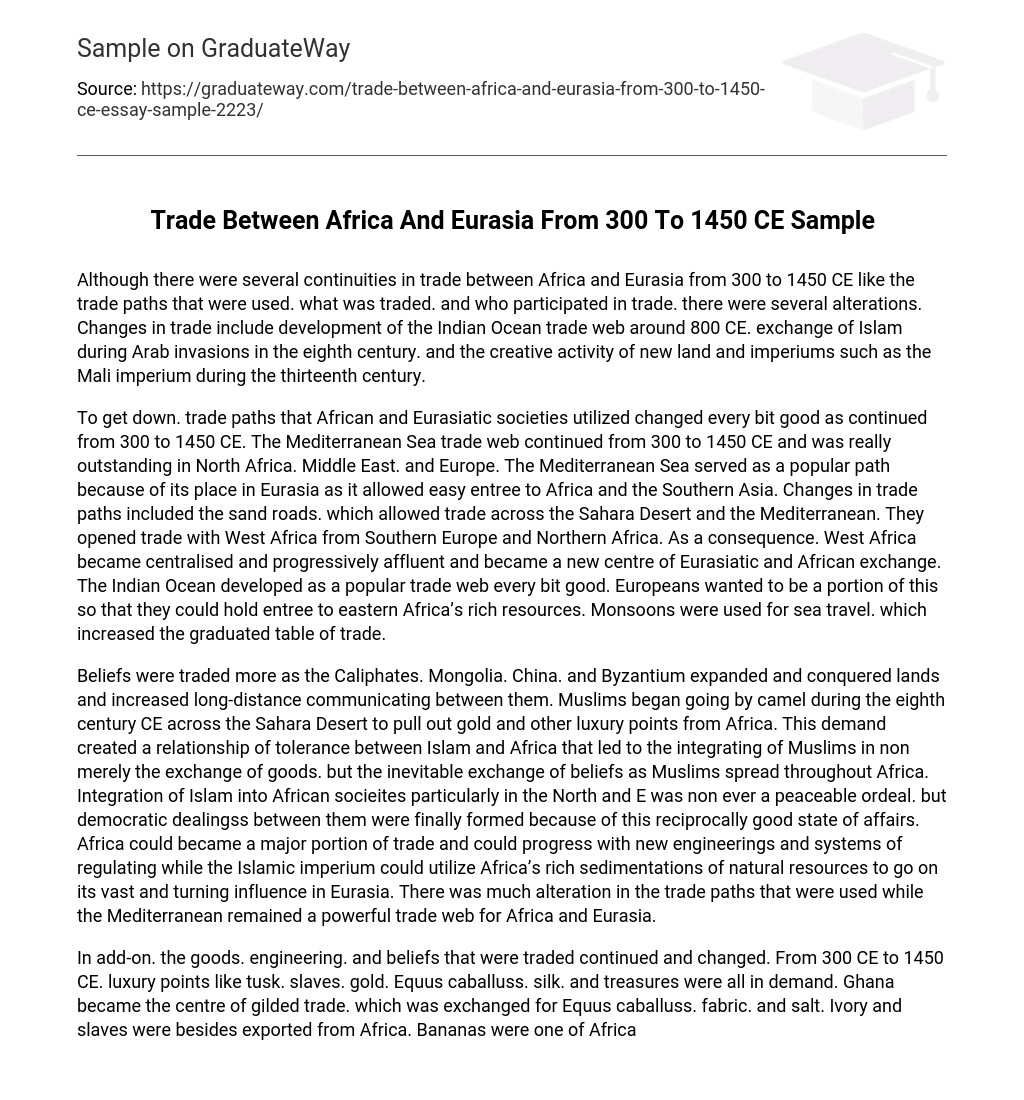Although there were various consistencies and changes in trade between Africa and Eurasia from 300 to 1450 CE, including trade routes, commodities exchanged, and participants, significant alterations occurred. These changes comprised the establishment of the Indian Ocean trade network around 800 CE, the spread of Islam through Arab invasions in the eighth century, and the emergence of new empires like the Mali Empire in the thirteenth century.
The trade routes utilized by African and Eurasian societies underwent changes and continuations from 300 to 1450 CE. The Mediterranean Sea trade network remained prominent during this period, particularly in North Africa, the Middle East, and Europe. Due to its placement in Eurasia, the Mediterranean Sea provided convenient access to Africa and Southern Asia. Notable changes in trade routes included the sand roads, which facilitated trade across the Sahara Desert and the Mediterranean, connecting West Africa with Southern Europe and Northern Africa. Consequently, West Africa experienced centralization and increasing prosperity, becoming a new hub of exchange between Eurasia and Africa. Additionally, the Indian Ocean emerged as a popular trade network. European nations sought to join this network in order to access the resources of Eastern Africa. Sea travel was facilitated by the use of monsoons, which facilitated greater scale of trade.
As the Caliphates, Mongolia, China, and Byzantium expanded and conquered lands, beliefs were exchanged and long-distance communication increased. During the eighth century CE, Muslims started using camels to travel across the Sahara Desert to extract gold and luxury items from Africa. This demand resulted in a tolerant relationship between Islam and Africa, leading to the integration of Muslims not only in trade but also in the exchange of beliefs as they spread throughout the continent. The integration of Islam into African societies, particularly in the North and East, was not always peaceful. However, mutually beneficial relations eventually formed, allowing Africa to become a significant trade partner and benefit from new technologies and governing systems while the Islamic empire utilized Africa’s abundant natural resources to enhance its influence in Eurasia. Trade routes underwent significant changes, but the Mediterranean remained a robust network for trade between Africa and Eurasia.
In addition, from 300 CE to 1450 CE, the goods, technology, and beliefs that were traded continued and changed. Luxury items such as tusks, slaves, gold, horses, silk, and treasures were all in high demand. Ghana became the center of a lucrative trade where gold was exchanged for horses, fabric, and salt. Africa also exported ivory and slaves. Bananas were one of Africa’s main products. The traded goods remained relatively consistent throughout this time period. New technologies like printing, gunpowder, the compass, camel saddles and stirrups, and advancements in ship design that allowed for navigation using monsoons from eastern Asia were brought to Islamic empires and eventually spread into Africa through Islamic merchants. Islam entered Africa, particularly eastern Africa, as Muslims crossed the Sahara to trade. This change is seen in Islamic empires and lands like the Mali empire and the many Swahili city-states that emerged due to the integration of Muslims in commerce and everyday trade. While physical items such as manufactured goods and agricultural products remained largely the same during the Post-Classical age, ideologies were also exchanged.
Last, the participants in trade in Africa evolved over time. In the early years (300 CE), the majority of people were hunters, gatherers, and fishers, leading to limited trade with Eurasia. However, trade expanded with the emergence of large corporate groups in city states, lands, and empires such as Kilwa, the Kingdom of Kongo, and the Mali Empire. The conflicts between villages and territories necessitated the establishment of formal governments and a consolidation of cultural loyalties into larger groups that controlled trade with Eurasia. The increasing use of technologies in Eurasia further bolstered Africa’s trade relations with Eurasia.
Monsoons were utilized by Malay crewmembers to expedite travel between exchanges, resulting in a quicker travel time. Additionally, advancements were made in shipbuilding, creating stronger and more adaptable ships. The introduction of devices such as the compass further facilitated faster sea travel. As a result, trade paths were utilized, leading to an increase in trade and the integration of new empires and peoples into Eurasia’s trading networks. However, it should be noted that there were also continuities in terms of traders in Africa, as they did not possess the same level of control over Eurasian territories that would have enhanced their involvement in trade and led to changes in the loyalty of those involved in trade. This stability in conquest led to Africa undergoing changes once it was conquered. In contrast, Eurasia underwent less change due to reduced levels of warfare compared to previous times.
While there were certain consistencies in trade between 300 and 1450 CE in Eurasia, such as the trade routes utilized, the goods that were exchanged, and the participants involved, there were also notable changes. These changes encompassed the establishment of the Indian Ocean trade network by 1000 CE, the diffusion of Islam, and the emergence of new territories and empires in Eurasia.





